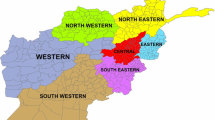Abstract
In this study, the traffic accidents recognizing risk factors related to the environmental (climatological) conditions that are associated with motor vehicles accidents on the Konya-Afyonkarahisar highway with the aid of Geographical Information Systems (GIS) have been determined using the combination of K-means clustering (KMC)-based attribute weighting (KMCAW) and classifier algorithms including artificial neural network (ANN) and adaptive network-based fuzzy inference system (ANFIS). The dynamic segmentation process in ArcGIS9.0 from the traffic accident reports recorded by District Traffic Agency has identified the locations of the motor vehicle accidents. The attributes obtained from this system are day, temperature, humidity, weather conditions, and month of occurred traffic accidents. The traffic accident dataset comprises five attributes (day, temperature, humidity, weather conditions, and month of occurred traffic accidents) and 358 observations including 179 without accident and 179 with accident. The proposed comprises two stages. In the first stage, the all attributes of dataset have been weighted using KMCAW method. The aims of this weighting method are both to increase the classification performance of used classifier algorithm and to transform from linearly non-separable traffic accidents dataset to a linearly separable dataset. In the second stage, after weighting process, ANN and ANFIS classifier algorithms have been separately used to determine the case of traffic accidents as with accident or without accident. In order to evaluate the performance of proposed method, the classification accuracy, sensitivity, specificity and area under the ROC (Receiver Operating Characteristic) curves (AUC) values have been used. While ANN and ANFIS classifiers obtained the overall prediction accuracies of 53.93 and 38.76%, respectively, the combination of KMCAW and ANN and the combination of KMCAW and ANFIS achieved the overall prediction accuracies of 74.15 and 55.06% on the prediction of traffic accidents. The experimental results have demonstrated that the proposed attribute weighting method called KMCAW is a robust and effective data pre-processing method in the prediction of traffic accidents on Konya-Afyonkarahisar highway in Turkey.








Similar content being viewed by others
References
Sawalha Z, Sayed D (2006) Transferability of accident prediction models. Saf Sci 44:209–219
Erdogan S, Yilmaz I, Baybura T, Gullu M (2008) Geographical information systems aided traffic accident analysis system case study: city of Afyonkarahisar. Accid Anal Prev 40(1):174–181
Levine N, Kim KE, Lawrence HN (1995) Spatial analysis of Honolulu motor vehicle crashes: I. Spatial patterns. Accid Anal Prev 27(5):663–674
Loo BPY (2006) Validating crash locations for quantitative spatial analysis: a GIS based approach. Accid Anal Prev 38(1):879–886
Andreescu MP, Frost DB (1998) Weather and traffic accidents in Montreal, Canada. Clim Res 9:225–230
MacQueen B (1967) Some methods for classification and analysis of multivariate observations. Proceedings of 5th Berkeley symposium on mathematical statistics and probability, University of California Press, Berkeley, 1:281–297
Bezdek JC (1981) Pattern recognition with fuzzy objective function algorithms. Plenum Press, New York
Yager RR, Filev DP (1994) Generation of fuzzy rules by mountain clustering. IEEE Trans Syst Man Cybern 24:209–219
Chiu SL (1994) Fuzzy model identification based on cluster estimation, J Intell Fuzzy Syst 2
Rui Xu, Donald Wunsch II (2005) Survey of clustering algorithms. IEEE Trans Neural Netw 16(3):645–678
Guldemır H, Sengur A (2006) Comparison of clustering algorithms for analog modulation classification. Expert Syst Appl 30(4):642–649
Dirgenali F, Kara S (2006) Recognition of early phase of atherosclerosis using principles component analysis and artificial neural networks from carotid artery Doppler signals. Expert Syst Appl 31(3):643–651
Jang JSR (1992) Self-learning fuzzy controllers based on temporal backpropagation. IEEE Trans Neural Netw 3(5):714–723
Jang JSR (1993) ANFIS: adaptive-network based fuzzy inference systems. IEEE Trans Syst Man Cybern 23(03):665–685
Tsoukalas LH, Uhrıg RE (1996) Fuzzy and neural approaches in engineering. Wiley, New York
Lewis D, Gale W (1994) A sequential algorithm for training text classifiers. Annual ACM conference on research and development in information retrieval, the 17th annual international ACM SIGIR conference on research and development in information retrieval, New York, 3–12
Ma Y, Guo L, Cukic B (2006) A statistical framework for the prediction of fault-proneness, advances in machine learning application in software engineering. Idea Group Inc
Fawcett F (2005) An introduction to ROC analysis. Pattern Recogn Lett 27(8):861–874
Güneş S, Polat K, Yosunkaya Ş (2010) Efficient sleep stage recognition system based on EEG signal using k-means clustering based feature weighting. Expert Syst Appl 37(12):7922–7928
Durduran SS (2010) A decision making system to automatic recognize of traffic accidents on the basis of a GIS platform. Expert Syst Appl 37(12):7729–7736
Polat K, Durduran SS (2010) Ensemble of classifiers for intelligent recognition of traffic accidents using a geographical information systems platform, 1st international symposium on computing in science and Engineering (ISCSE), June 3–5, 2010, Kuşadası, Türkiye
Frank A, Asuncion A (2011) UCI machine learning repository. University of California, School of Information and Computer Science, Irvine, CA. http://archive.ics.uci.edu/ml
Polat K, Güneş S (2006) A hybrid medical decision making system based on principles component analysis, k-NN based weighted pre-processing and adaptive neuro-fuzzy inference system. Digital Signal Process 16(6):913–921
Author information
Authors and Affiliations
Corresponding author
Rights and permissions
About this article
Cite this article
Polat, K., Durduran, S.S. Automatic determination of traffic accidents based on KMC-based attribute weighting. Neural Comput & Applic 21, 1271–1279 (2012). https://doi.org/10.1007/s00521-011-0559-9
Received:
Accepted:
Published:
Issue Date:
DOI: https://doi.org/10.1007/s00521-011-0559-9




